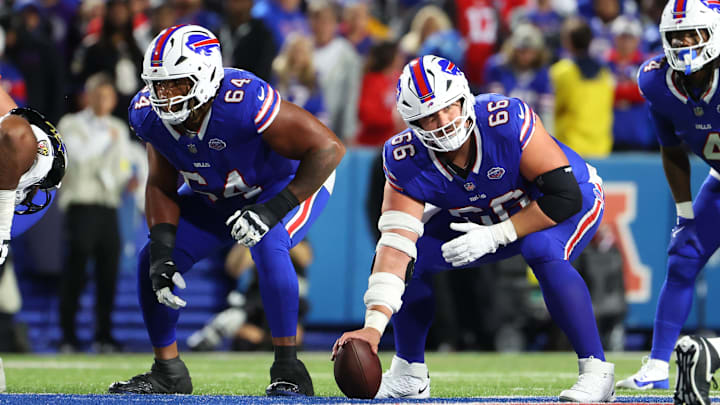In the modern NFL, few positions are as scrutinized, as physically demanding, or as technically nuanced as those in the offensive line.
And yet, for the Buffalo Bills, the unit protecting quarterback Josh Allen and paving the way for a dynamic running game has remained a steady point of excellence -- a consistency that owes much to offensive line coach Aaron Kromer.
Kromer, a veteran with a reputation for developing talent across the league, has cultivated a culture in Buffalo that emphasizes fundamentals, versatility, and situational awareness, all while maximizing the potential of both drafted talent and under-the-radar acquisitions.
Under his guidance, the Bills’ offensive front has produced not only immediate starters, but a deep rotation that allows for adaptability in the face of injuries and game-to-game matchups.
Developing Top-Tier Talent: O'Cyrus Torrance and Deion Dawkins
One of the clearest examples of Kromer’s developmental acumen is second-round pick O'Cyrus Torrance, drafted in 2023. Entering the league with tools that suggested high potential but also with areas needing refinement, Torrance has benefited from Kromer’s hands-on approach.
Under Kromer, Torrance has developed his hand placement, leverage, and technique, quickly turning into a reliable presence in the interior line rotation and fine tuning the 'little things' that limited him out of Florida.
His growth underscores Kromer’s philosophy: while athleticism can be a foundation, the refinement of technique and mental processing separates good linemen from great ones.
At the same time, Kromer has overseen the development of Deion Dawkins, who has emerged as one of the premier left tackles in football. Dawkins’ journey is a blueprint for Kromer’s approach.
Recognizing raw talent is one thing; molding it into consistent, elite-level production is another. Through meticulous coaching on stance, footwork, and situational recognition, Dawkins has transformed into a cornerstone of the Bills’ protection schemes. His presence on the left side not only shields Allen from the league’s top edge rushers, but also provides a stable anchor for the running game.
Together, Dawkins and Torrance illustrate the dual success Kromer has achieved: elite development at the highest level alongside the cultivation of young talent ready to step into key roles.
It's a type of balance that ensures the Bills are never over-reliant on a single player while simultaneously maintaining a top-tier line.
Depth and Versatility: Maximizing Backups
While developing first-team talent is critical, Kromer’s ability to extract production from backups has been equally impressive. Ryan Van Demark, who made his first start of 2025 in Week 4, provides a prime example. Van Demark, a former UDFA out of UConn, has been integrated into the rotation carefully, allowing him to gain experience without the pressure of being thrown into over his head.
Kromer’s coaching has emphasized fundamentals, proper alignment, and awareness of defensive tendencies, helping the third year pro transition smoothly to live NFL action.
Similarly, former undrafted free agent Alec Anderson has flourished under Kromer’s tutelage, offering guard versatility that has proven invaluable for the Bills.
In a league where depth is often tested due to injuries or situational substitutions, having reliable, multi-positional backups allows a team to maintain offensive efficiency. Anderson’s ability to step into different roles while remaining technically sound demonstrates Kromer’s capacity to get the most out of every roster spot.
It's the kind of depth that is particularly important in the modern NFL, where defenses are scheming to exploit any weaknesses along the line. By preparing backups not just to fill in, but to contribute effectively in their own right, Kromer ensures the Bills’ offensive schemes -- both in protection and run-blocking -- remain fluid and effective even when rotation is necessary.
Paving the Way for the Running Game
The success of the Bills’ rushing attack is intertwined with the offensive line’s performance. With three legit options in the backfield, along with Allen's ability with the ball in his hands, the line’s role extends beyond protection into creating lanes, sustaining blocks, and adjusting to defensive stunts in real time. Kromer’s approach emphasizes cohesion and communication, ensuring that all five linemen operate as a unit rather than as individuals.
The line’s performance doesn’t just reflect talent -- it reflects preparation.
Protecting Josh Allen: Technique Meets Strategy
Perhaps the most visible metric of Kromer’s success is the protection of Josh Allen. The quarterback’s combination of mobility, arm strength, and downfield vision demands a line capable of both traditional pass protection and dynamic adjustments. Kromer’s coaching ensures that linemen are disciplined in their assignments while also understanding when to react to unique defensive looks.
Dawkins’ growth as a left tackle, coupled with the development of interior linemen like Torrance, and even the progression of Spencer Brown, has created a protective wall that allows Allen to operate with confidence.
Meanwhile, backups like Van Demark and Anderson provide insurance against injuries without disrupting continuity. The result is an offensive line that balances elite performance with depth and adaptability -- a direct reflection of Kromer’s attention to detail.
The Pipeline Philosophy
Kromer’s success in Buffalo is not just about developing individual players, it’s about creating a sustainable pipeline of talent. From high-round picks to undrafted free agents, Kromer maximizes the potential of every lineman on the roster. This pipeline ensures the Bills’ offensive line remains a competitive advantage year after year.
Whether it’s refining the technical skills of a rookie like Torrance, transforming Dawkins into a premier left tackle, or extracting production from versatile backups like Van Demark and Anderson, Kromer’s impact is clear: the offensive line is not just a collection of players -- it’s a culture, a system, and a development machine that reflects his philosophy.
